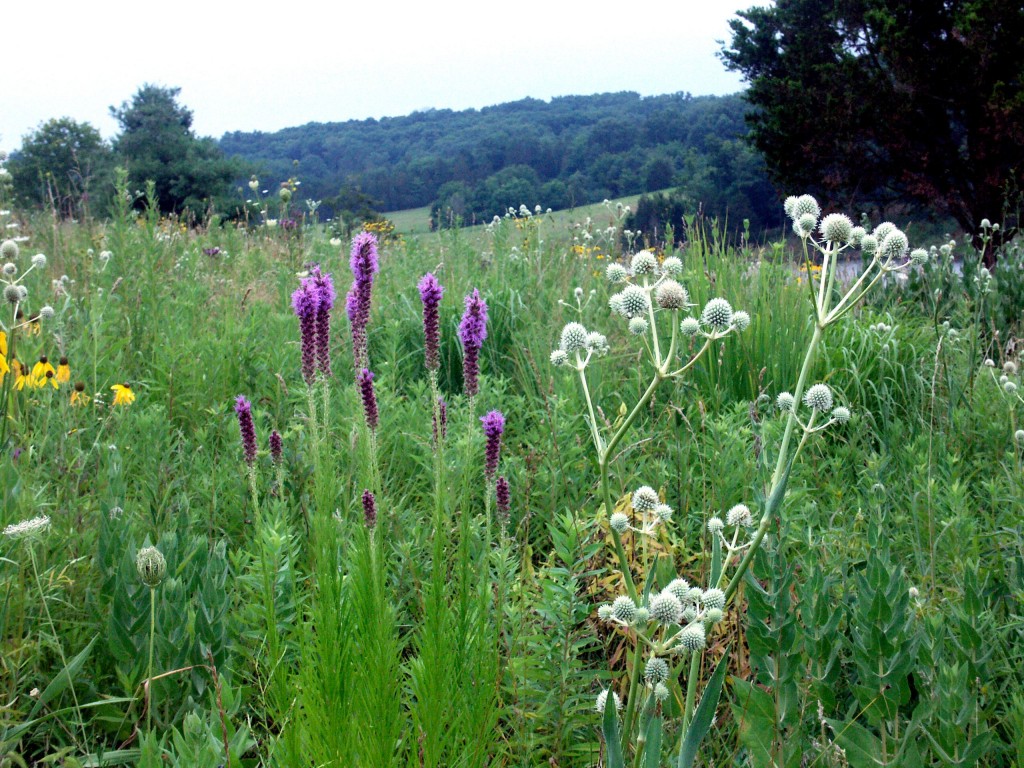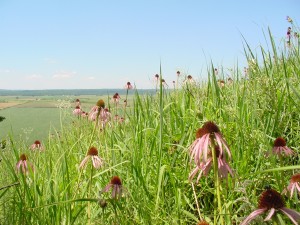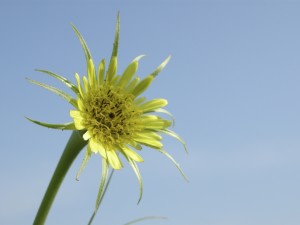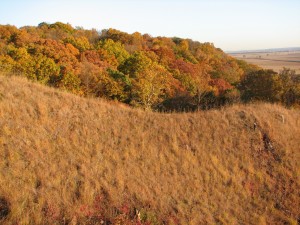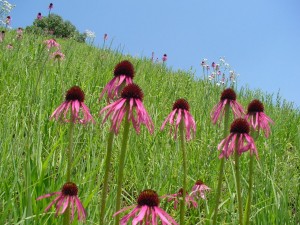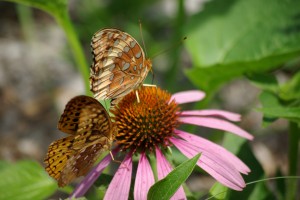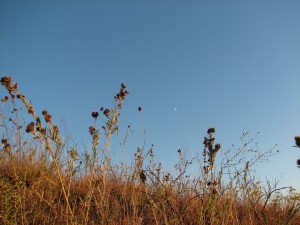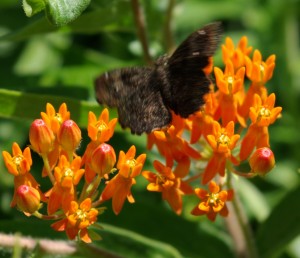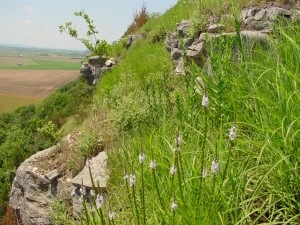Prairie Patches Are Small Relics of Once Vast Ecosystems
Illinois, the “Prairie State,” once was a part of a vast grassland, stretching from Indiana to Nebraska, from Texas to Saskatchewan, called the tallgrass prairie. In 1800, 22 million acres of Illinois were tallgrass prairie and 14 million acres were forest.
Millions of years ago, because of the Rocky Mountain uplift, a large rain-shadow was created in the middle of the continent. A precipitation gradient, running west-to-east, became the dominant factor in what grows where. The height of grasses and frequency of trees increase as you move from the foot of the Rockies, across the Midwest, and into the Appalachians. After the last ice age, 10,000 years ago, distinct species of drought-tolerant plants took hold to form the huge swathes of prairie in Illinois.
Even as they declared it “wilderness,” the heavily-forested terrain of
eastern North America remained recognizably similar to the homelands of early European explores and settlers. There was, further, familiarity in land use due to horticultural practices of Amerindians, who opened small fields within the vast forests.
But for those who initially explored and then those settlers who slowly “westered-on” as they cut down timbers to homestead through the ever-shrinking eastern forests, the tallgrass prairie offered no frame of reference. They had never seen or heard of the steppes of Asia, the African veldt, or the South American pampas.
The first European explorers who ventured into the tallgrass prairie were astounded by its vast expanse, seemingly so devoid of landmarks that it was comparable only to the empty seas. Louis Joliet, after his legendary 1673 exploration down the Illinois and Mississippi Rivers, reported on “limitless expanses of prairies, miraculous oceans of grasslands, stretching as far as the eye could see.”
Even the word “prairie” hints at the difficulty early explorers had in grasping the uniqueness of this new place and their struggle for cultural referents. This word was coined in the 18th century and was derived from the Old French praerie which was rooted in the Latin word pratum for “meadow.” The word, though evocative of a familiar European landscape — an enclosed grassy area, dotted with daisies and poppies and regularly mowed for animal fodder — could not itself possibly contain the vast wild ecosystem that was the tallgrass prairie. No longer a referent to meadow, the word prairie grew even as that landscape was being transformed, into its modern meaning: an expansively open, unconfined area dominated by grasses and the absence of many trees.
A tallgrass prairie simply is an association of distinct grasses and forbs (mostly flowering composites and legumes) growing close together, sharing time, space and nutrients. Over time, prairie plants adapted to survive the extremes in temperature, drought, wind, high light intensity, grazing by large herbivores (bison and elk), as well as underground disturbance by burrowing animals, and disturbance by fire, which prevents the establishment and succession of trees.
Here, too, word usage tells a distinct story, but one far different from and having no analogy to a meadow. For Native American peoples of the mid-continent, prairie and fire were one and the same word. Prairie plants survive because their roots and rhizomes are protected from the searing heat of prairie fires which burn through dried and dead vegetation in the late fall through early spring dormant-growth season.
A tallgrass prairie is a quiltwork of plant cooperation and a kaleidoscope of colors, bloomtimes, heights and shapes, all wafting in the winds from early spring to late fall. What you see in looking over a prairie is only a third of the dynamics of the ecosystem. Prairies are root-driven communities with two-thirds of their biomass underground. Deep, very deep roots insure plant survival in a landscape hospitable only to very drought tolerant plants. A
gardener knows, for example, that time, some effort and a shovel will suffice to transplant a daylily or a rose. But moving a prairie coneflower sets the patient gardener to considerable effort with a very long-bladed spade. A transplant-minded gardener would be better prepared to deal with an established compass plant by using a back hoe.
Most of the metabolic activity in a prairie occurs at the root-soil interface, the rhizosphere. During photosynthesis prairie plants move energy-rich compounds to their roots, where they are released into the surrounding soil and serve as carbon and vitamins for microbes. The microbes, in turn, help transport other nutrients back to the plant roots. This microbe-plant symbiotic association brings huge levels of biomass and energy to a prairie ecosystem.
And, were there’s biomass and energy aplenty, there’s food and shelter for a myriad of animals. Insects galore — especially large crickets, grasshoppers and leafhoppers — live out their lives in prairies. Dozens of species of our local butterflies use only prairie
plants as larval hosts. Over 60 species of our butterflies congregate on prairie plants, like multicolored shavings drawn to a magnet, for nectaring sources.
Where bugs abound, our birds follow. Upland Sandpipers, meadowlarks, bobwhite quail, shrikes, kestrels, bobolinks, Northern Harriers, and Grasshopper and Henslow’s Sparrows are commonly found in a tallgrass prairie ecosystem.
For us, a tallgrass prairie is akin now to slow paging through a greatly over-sized wall calendar with gorgeous images of exotic places. Every month brings to us new pictures of striking beauty and memories of our ancient lands. But our calendar is sepia-toned and edge-frayed for our tallgrass prairies exist now only as place names on old plat maps.
New Design Prairie and Prairie du Rond (Round), which quickly was renamed Yankee Prairie, were smaller prairie patches east of present-day Burksville in Monroe County. They became the centerpiece of Illinois’ first post-Revolutionary War settlement area, the New Design Colony. New Design established the first school
house in the state in the early 1780s and the children may have admired the prairies on their walks there or, perhaps, were tardy to school as they lingered to chase a butterfly .
Flat Prairie was located 20 miles east of Fort Kaskaskia, in the Cox Creek area of Randolph County. History holds that it was so flat, and its expansive grasses so flourishingly tall, that a horseman had to stand on the back of his mount for any hope of spying another approaching rider.
Big Prairie, in Monroe and St. Clair Counties, ran for miles in the American Bottoms between old Fish Lake and the bluffs, from present-day Columbia toward Cahokia. James Piggot built a fortified homestead overlooking the prairie in 1783, along the Kaskaskia Trail, at the base of the bluffs, just west of what now is Columbia. Two men died on the prairie in 1806, when lightening created a firestorm.
Horse Prairie, located in northern Randolph County between Sparta and Marissa, covered nine square miles of territory. The prairie got its name from stories of wild horses which once roamed the prairie. That legend gained new currency when, in 1803, a long-remembered horse race was held on the prairie. Bets up to $500 were wagered, an astronomic sum of money for the time, guaranteeing that the race would live on in memory, even as the prairie was converted to agricultural fields.
And, Prairie du Long, aptly named on two counts, stretched for 20 long miles from southern St. Clair County, through Monroe County’s eastern panhandle, and into Randolph County. The prairie also lasted the longest, with settlement of the area and conversion to agriculture not occurring until the mid-1800s.
While the place names endure, only remnants of tallgrass prairie live on. In Illinois, only 2000 acres of original tallgrass prairie
remain. But interesting variations, called hill prairies, still festoon the precipitous river bluff tops above the cliff face in Monroe and Randolph Counties. And, tallgrass prairie reconstruction is becoming increasingly popular in our area. Several state sites, such as Illinois Caverns Natural Area, near the historic New Design prairies, have reconstructed prairies and dozens of local landowners have reestablished prairies. These prairie patches — though only small relics of a once vast ecosystem — still bear witness to the unique nature of the tallgrass prairie.
Clifftop, a local nonprofit organization, is focused on preserving and protecting area bluff lands.
A version of this article appeared in the January 2 2008 edition of the Monroe County Clarion.
© 2008 all content rights reserved, Clifftop NFP.
Comments are currently closed.

